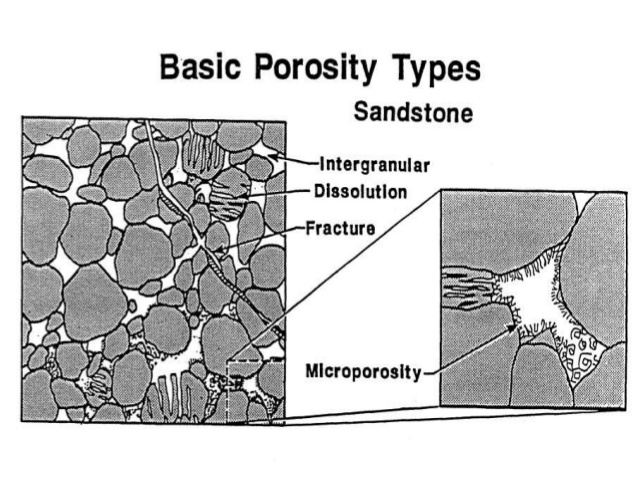Porosity is a measure of the void space within a rock, expressed as a fraction (or percentage) of the bulk volume of that rock. To be commercially productive, a reservoir must have sufficient pore space to contain a appreciable volume of hydrocarbons. Porosity defines the storage capacity of a sedimentary formation for oil, gas and water. The general expression for porosity is:

Where: f = Porosity
Vb = Bulk Volume of the Rock
Vs = Net Volume occupied by solid (grain volume)
Vp = Pore volume
In reservoir rocks porosity is classified as Absolute Porosity (total porosity of a rock) and Effective Porosity (the porosity of void spaces which are interconnected). It is the effective porosity which is of interest to the oil industry and reservoir engineers. Effective Porosity is the amount of porosity able to transmit fluid. In unconsolidated and moderately cemented formations, the absolute porosity is approached by the effective porosity. However, in highly cemented sandstones and carbonates, the absolute porosity is much larger than the effective porosity.

NB: When used in calculations, porosity is expressed as a number between zero and one. For example, 20% = 0.2, 8% = 0.08
Geologically, porosity has been classified in two types, according to the time of formation.

Primary Porosity
Porosity formed at the time the sediment was deposited. The voids contributing to this type are the spaces between individual grains of the sediment. Primary porosity is a function of the packing, sorting, rounding, compaction and cementation effects. It is intergranular porosity of sandstones and the oolitic or intercrystalline porosity of carbonates.
Secondary Porosity
Porosity formed after the sediment was deposited. The magnitude, shape, size and interconnection of the voids bear no relation to the form of the original sedimentary particles. Secondary porosity has been divided into three classes based on the mechanism of formation.
Solution Porosity - Voids formed by the solution of the more soluble portions of the rock by percolating surface and subsurface waters. Inconformities in sedimentary rocks are excellent targets for zones of solution porosity.
Fractures, Fissures and Joints - Voids formed by the structural failure of the rock under loads caused by various forms of diastrophism, such as folding and faulting. This type of porosity is extremely hard to evaluate due to its irregularity.
Dolomitization - Voids formed when limestone is transformed into dolomite. Porosity formed by dolomitization is due to the solution effects enhanced by a previous chemical change in limestone.
It is wrong to assume that there is a unique minimum porosity cut off which defines all reservoir rocks. A typical value for a clean, consolidated and reasonably uniform sand is 20%. A rough average for carbonate rocks is 6 to 8%. Remember though, these values are approximate and will not fit all situations.

%20(1).png)



